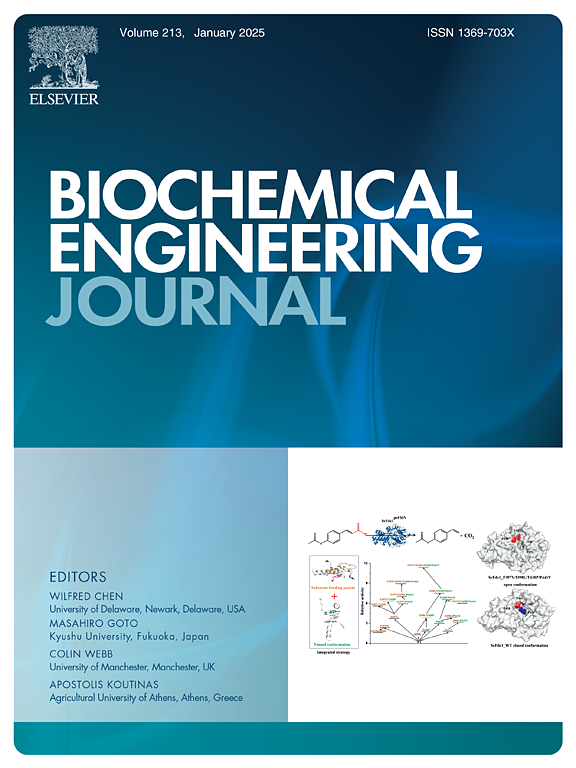隐式大涡流模拟流体动力应力表征在125 mL摇瓶干细胞培养
IF 3.7
3区 生物学
Q2 BIOTECHNOLOGY & APPLIED MICROBIOLOGY
引用次数: 0
摘要
基于诱导多能干细胞的细胞疗法为多种不同疾病提供了有希望的新疗法。然而,干细胞对水动力应力的敏感性使得开发可靠的干细胞生产工艺具有挑战性。了解干细胞在早期过程发育过程中所经历的流体动力应力条件对于指导按比例放大和设计按比例缩小的实验具有重要意义。我们用格点-玻尔兹曼隐式大涡模拟(LB-ILES)来表征125 mL摇瓶中的流体动力应力。首先,我们使用体积功率输入测量和实验液体分布数据验证了LB-ILES摇瓶模拟,显示出良好的总体一致性,同时还讨论了LB-ILES方法在网格和时间步长依赖性方面的数值挑战。当振动频率从55 ~ 250 rpm增加时,振动瓶内的平均剪应力从0.01 ~ 0.24 Pa增加,平均Kolmogorov长度尺度从185 ~ 51 μm减小。此外,我们评估了剪切应力和Kolmogorov长度尺度的时间平均分布,并将其与干细胞的应力阈值进行了比较。基于剪切应力和Kolmogorov长度尺度分布,我们开发的摇瓶CFD模型可以帮助设计小规模实验来表征干细胞培养物的流体动力应力耐受力,并最终指导将干细胞培养物扩大到更大的培养系统。本文章由计算机程序翻译,如有差异,请以英文原文为准。
Implicit large eddy simulations for hydrodynamic stress characterization in 125 mL shake flasks for stem cell cultures
Cell therapies based on inducible pluripotent stem cells offer promising new treatments for a variety of different illnesses. However, the sensitivity of stem cells to hydrodynamic stress makes developing reliable stem cell production processes challenging. Understanding hydrodynamic stress conditions experienced by stem cells during early-stage process development is important to guide scale-up and design scale-down experiments. We characterize the hydrodynamic stresses in a 125 mL shake flask using Lattice-Boltzmann implicit large eddy simulations (LB-ILES). First, we validated the LB-ILES shake flask simulations using volumetric power input measurements and experimental liquid distribution data showing good overall agreement, while also numerical challenges of the LB-ILES method regarding grid and time step dependencies are discussed. The mean shear stress in the shake flask increases from 0.01 to 0.24 Pa when increasing the shaking frequency from 55 to 250 rpm, and the mean Kolmogorov length scale decreases from 185 to 51 μm. Furthermore, time-averaged distributions of the shear stress and Kolmogorov length scales were evaluated and compared to reported stress thresholds for stem cells. Based on the shear stress and Kolmogorov length scale distributions, our developed shake flask CFD model can help to design small-scale experiments to characterize stem cell cultures in terms of their hydrodynamic stress tolerance, and ultimately guide scale-up stem cell cultures to larger cultivation systems.
求助全文
通过发布文献求助,成功后即可免费获取论文全文。
去求助
来源期刊

Biochemical Engineering Journal
工程技术-工程:化工
CiteScore
7.10
自引率
5.10%
发文量
380
审稿时长
34 days
期刊介绍:
The Biochemical Engineering Journal aims to promote progress in the crucial chemical engineering aspects of the development of biological processes associated with everything from raw materials preparation to product recovery relevant to industries as diverse as medical/healthcare, industrial biotechnology, and environmental biotechnology.
The Journal welcomes full length original research papers, short communications, and review papers* in the following research fields:
Biocatalysis (enzyme or microbial) and biotransformations, including immobilized biocatalyst preparation and kinetics
Biosensors and Biodevices including biofabrication and novel fuel cell development
Bioseparations including scale-up and protein refolding/renaturation
Environmental Bioengineering including bioconversion, bioremediation, and microbial fuel cells
Bioreactor Systems including characterization, optimization and scale-up
Bioresources and Biorefinery Engineering including biomass conversion, biofuels, bioenergy, and optimization
Industrial Biotechnology including specialty chemicals, platform chemicals and neutraceuticals
Biomaterials and Tissue Engineering including bioartificial organs, cell encapsulation, and controlled release
Cell Culture Engineering (plant, animal or insect cells) including viral vectors, monoclonal antibodies, recombinant proteins, vaccines, and secondary metabolites
Cell Therapies and Stem Cells including pluripotent, mesenchymal and hematopoietic stem cells; immunotherapies; tissue-specific differentiation; and cryopreservation
Metabolic Engineering, Systems and Synthetic Biology including OMICS, bioinformatics, in silico biology, and metabolic flux analysis
Protein Engineering including enzyme engineering and directed evolution.
 求助内容:
求助内容: 应助结果提醒方式:
应助结果提醒方式:


